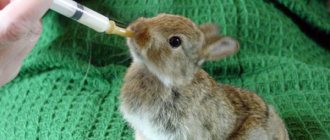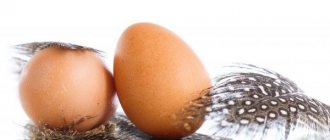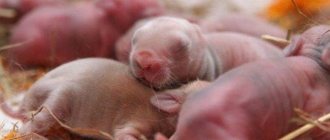Is it possible to feed baby rabbits without a mother rabbit?
It is possible to feed the offspring of rabbits without a female, although the process will require time and money. Organizing such a meal requires purchasing certain supplies, following schedules, and spending a lot of time with the kids. The main difficulties occur in the first weeks of the rabbits’ lives. As they grow older, the need for constant support disappears, and animals become independent.
Kids with a rabbit
Artificial feeding is considered undesirable unless absolutely necessary. Wrong actions can reduce the survival rate. Third-party nutrition and human care will not completely replace mother's milk and care. Meanwhile, there are cases where orphaned babies grew stronger, thanks to the hard work of breeders.
Newborn rabbit
The procedure is required if certain problems occur:
- death of the female. Sometimes the female rabbit dies during or after childbirth. It is very difficult to predict a sad outcome;
- atrophied parental instinct. It often happens during the first litter of young individuals. The new mother does not want to feed her offspring. In most cases, the instinct can be forcibly awakened by holding the female several times while feeding the babies. However, there are times when no tricks help;
- craving for hunting. Restless rabbits can abandon their children within a day after giving birth. They begin to run around the living space, furiously searching for food. In such impulses, rabbits often die from accidental trampling by their own mother. It is proposed to solve the problem through provocation. They mate with a male who is unable to conceive. After this, the female can calm down. If the attempt is unsuccessful, artificial feeding cannot be avoided;
- sore nipples. It is also more common in young female rabbits. Coarsened skin does not allow milk to pass smoothly, the process causes severe inconvenience to the mother and she stops allowing her offspring to pass;
- pungent odors. Rabbits are sensitive to foreign odors. The most unpleasant for them are shades of alcohol, perfume, household and technical liquids. Sometimes the smells of other animals living in the neighborhood play a cruel joke. Discomfort leads to the attenuation of instincts.
Breastfeeding baby rabbits by another mother
In these situations, if possible, you should try placing the babies with another mother. However, not every female rabbit will willingly accept someone else's offspring. In addition, a large number of babies will lead to exhaustion of the female. Therefore, experienced farmers prefer to immediately get down to business on their own.
This is interesting: What grass can and cannot be given fresh to rabbits - let’s get to the bottom of it
What and how to feed after transplanting?
After weaning from their mother, the rabbits remain vulnerable to external conditions for another month and a half. Their immune system is very weak, and their digestive system is still imperfect . That is why the issue of nutrition for children needs to be given a lot of attention. Their diet should be varied, but do not forget that young animals still cannot eat everything the same as adults.
The rabbits began to receive their first complementary food at the age of three weeks; they tried twig food, hay, vegetables, grain food, and various mash with bran and potatoes from their mother’s feeder. But while the cubs were with their mother, they drank her milk, which maintained an optimal level of acidity and microflora in their stomachs. After weaning from the mother, the digestive system is completely rebuilt in a new way. During this period, the level of acidity in the stomach of babies decreases sharply. This means that mistakes made in nutrition will not pass without a trace: diarrhea, inflammation of the intestines, and death are possible.
It is important for the farmer to try to prevent such problems. Nothing like this will happen if at first you feed the babies food that is already familiar to them, which the rabbit ate while she was with the cubs. Any new foods should be introduced gradually, starting with small portions. This rule is especially important to follow if greens are introduced into the diet. Fresh grass is always dried and given a little at a time. A new portion of food is offered at the appropriate time, when the previous one is completely eaten. The daily amount of food should be increased gradually.
Attention! Little rabbits are prone to overeating, so it is worth controlling the amount of food eaten. You should not put more food in the feeder than the babies need.
Rabbits can be weaned from their mother starting from the age of one month, if by this time they have already increased their body weight 10 times, acquired permanent teeth and learned to eat adult food on their own. If these conditions are not met, you should wait a little. Mother's milk contains antibodies that are beneficial for rabbits, which help them resist diseases. While babies drink it, a normal pH level is maintained in their intestines, which helps avoid digestive problems.
Measuring parameters of baby rabbits after jigging
When laying, anthropometry of the rabbits is mandatory: they are weighed, their gender is determined, and their health status is assessed.
The body weight of the baby rabbit should approximately correspond to the data below - according to age and breed.
You can find out the sex of baby rabbits from the 20th day after birth. Eared animals are placed on their backs, their tails are pulled back and their gender is checked: in females, the genital organ is located close to the anus, and the penis of males looks like a larger hole and is located far from the anus.
It is important during this period to determine whether the baby is healthy.
Signs of a healthy baby rabbit:
- the animal is playful, active, there is a reaction to sound, light, touch;
- a good appetite;
- the nose is clean, there is no discharge;
- eyes are bright and shiny;
- the coat is clean, smooth, without bald spots, with a slight sheen;
- body temperature is normal (38‒39 °C);
- rhythmic breathing (50‒60 times/min);
- pulse is accelerated, rhythmic (125‒165 beats/min).
Rabbits that are lagging behind in development are recommended to be placed separately from healthy relatives. To make them stronger, they are switched to highly nutritious feed. Severely weakened animals are discarded by slaughter.
How to plant young animals correctly?
The weaning process involves quite a lot of hassle. The rabbit breeder needs to take into account a number of factors: proper preparation of cages for keeping young animals, development of a balanced diet, organization of competent care, and so on and so forth. Next, we will try to figure out how to avoid making mistakes when laying baby rabbits, and what aspects of this process should be paid special attention to.
Determining the readiness of young animals for weaning from a female
First of all, it is necessary to assess the condition of the offspring. In this case, it is necessary not only to evaluate the entire litter, but also to pay attention to each specific cub. This allows you to understand how successful the birth was, as well as determine the milk characteristics of each specific lactating female. If the litter does not have enough milk, you can place the baby rabbits with another rabbit who has plenty of milk.
As a rule, before weaning, rabbits are divided into several weight categories, and groups are formed for separate housing together.
This makes it possible to individually feed individuals of different weights and physical conditions, which allows both large and smaller and weaker rabbits to grow successfully.
In addition to weight indicators, young animals are also sorted according to the following criteria:
- gender;
- fatness;
- body length and height at the withers.
Weaker rabbits need to be provided with a diet of increased calorie content, while larger and stronger individuals can reduce the proportion of such products.
If the cubs lag behind their brothers in height, they are placed in a separate pen. Since weakened specimens are not suitable for further breeding, they are usually fattened for slaughter for meat. In addition, rabbits that lag behind the general mass of young animals in their development are more often susceptible to various kinds of diseases (including infectious ones).
To minimize the risk of infection of healthy and strong livestock, such animals must be isolated from the main herd.
More on the topic: The female rabbit does not tear down the fluff, does not make a nest and carries hay in her teeth before giving birth
Existing methods of planting young animals
The main methods used in this process are:
- whole: implies the simultaneous separation of all offspring from the female, in parallel dividing the young into different groups, guided by the criteria of live weight and the general level of development of the animals;
- temporary method: based on the fact that first all the offspring are taken from the female rabbit, and then the cubs are periodically returned to her for a short period of time for suckling. This makes it possible to soften the abrupt transition to new types of food, which can negatively affect the health of still fragile babies;
- sorting method: the basis of this technique is the gradual separation of the largest rabbits from the female, which they try to wean first. Weaker individuals remain on suction for some time.
What should be done when weaning young animals?
First of all, it is necessary to provide constant and thorough care for the rabbits in the first one to two months. It is this period of time that is characterized by the fastest growth rates of the cubs, and at the same time the first molt takes place. In addition, after weaning, babies are most prone to various types of gastrointestinal diseases. Practice shows that in the absence of mother's milk, there is often an overload in the digestive system of rabbits. They are not yet able to fully digest and assimilate all “adult” food.
In this regard, feeding young animals in the first days after laying should be organized in such a way as to facilitate the work of their digestive system as much as possible.
The breeder decides how many times to feed the animals, but the released young animals must receive food at least three times a day. Portions should be small and crushed. If the diet contains concentrated types of feed, they must be thoroughly crushed before distributing to the rabbits.
It is important to remember that at the very beginning of self-feeding, the cubs’ diet should consist of the same food that the mother rabbit ate immediately before weaning the offspring.
Any new food products should be introduced into the diet gradually, starting with small doses and constantly monitoring the reaction of young rabbits.
Tips for bottle feeding
In cases where the rabbit has died or refuses to feed the babies, you should begin this responsible mission yourself.
Self-feeding baby rabbits
Selecting milk
The only thing better than mother's milk is mother's milk! Unfortunately, children are not always given the opportunity to fully enjoy its most valuable nutritional properties. In cases where this is not possible, you can try to select milk that is similar in composition.
The closest approximation in structure is deer milk
Comparison of the nutritional properties of milk from different animals
| Animal | Content, % | ||||
| Water | Squirrels | Fats | Lactose | Salts | |
| Cat | 81,5 | 9,3 | 3,5 | 4,9 | 0,7 |
| Cow | 87,3 | 3,4 | 3,6 | 50 | 0,7 |
| Deer | 65 | 14-12 | 17 | 2,8 | 1,5 |
| Goat | 87,9 | 3,7 | 4,0 | 4,5 | 0,9 |
| Sheep | 84,0 | 5,1 | 6,1 | 4,2 | 1,0 |
| Dog | 77,0 | 9,7 | 9,3 | 3,1 | 0,9 |
It is also saturated with proteins and fats, but getting it seems problematic. Based on these data, it can be seen that deer milk is optimally close in structure to rabbit milk.
So popular all over the world, cow's milk, due to its characteristics, is not entirely suitable for feeding eared animals. An insufficiently high percentage of protein content removes it from the list of potential breast milk substitutes. Next after deer milk in terms of reliability is dog milk.
Feeding rules
In the process of self-feeding babies, you should follow simple rules:
- buy dog milk powder at the pet store;
- dilute it with water, following the recommendations specified in the instructions, and bring the liquid to a temperature of 36C;
- It is necessary to feed babies only from a pipette or a special insulin syringe in which the needle has been previously removed;
When self-feeding, use a thin pipette
it is necessary to pour in the milk with extreme caution: it is very important to avoid getting liquid into the nose, otherwise the baby may choke;
Be careful not to get any liquid into your nose during feeding.
Overeating should not be allowed: you can determine the baby’s level of satiety by his even, smooth tummy.
The degree of saturation of the baby rabbit with food can be determined by its smooth tummy
The nuances of keeping bottle-fed rabbits
In the first hours of life, rabbits deprived of maternal care, as a rule, die. If you respond to the situation quickly, you can save the babies and raise them healthy.
Rabbits should be placed in a warm place under a lamp.
Advice from experienced farmers on caring for bottle-fed rabbits:
- it is always necessary to breed several females at the same time: if one of them abandons the offspring, the babies should be placed in the nests of other rabbits;
- if a suitable mother is not found, it is recommended to put the babies in a warm place, preferably under a lamp: make sure that the lamp does not burn the fragile bodies of the baby rabbits;
- Since at this age the long-eared animals have not yet learned to empty themselves, it is necessary to massage their tummies: massage should be done only in one direction - from the navel to the hind limbs.
Be sure to massage the belly several times a day: this will help the rabbits to empty their bowels.
Treat your babies with the utmost responsibility and check their condition every few hours.
Basic Rules
When seeding rabbits, the breeder must adhere to the following rules:
- Distribute the animals into cages in groups according to their weight. It is impossible to keep strong and weakened individuals together, since the former will push the weaker ones away from food, as a result of which they may die.
- House females separately from males, since boys are strong fighters.
- Place no more than 4–5 individuals in each cage. The larger the group, the slower the young animals grow.
- It is desirable that all the placed rabbits come from the same family.
- If babies are separated from different rabbits, then they must be moved into the same cage at the same time, otherwise the “old-timers” will infringe on the new arrivals and fight with them.
- If there are still brawlers in the group, they need to be resettled separately, otherwise the clashes will become widespread.
When the rabbits are 3–3.5 months old, they need to be regrouped again: the strongest males are left for reproduction and placed one at a time, females are placed in cages of 2–3 individuals, the rest of the population is placed in 2 individuals per cage and fattened for slaughter.
The nuances of keeping bottle-fed rabbits
When artificially feeding baby rabbits, the rabbit breeder will have to face a number of special issues that you should definitely know and remember well:
- mandatory massage of the eared tummy to stimulate the intestines;
- cleaning the anus after bowel movements;
- mandatory addition of adult feces (namely caecotrophs) to the milk mixture;
- arrangement of a uterine nest with a darkened resting area and a heated bottom;
- maintaining the cleanliness of animals’ homes and all feeding equipment;
- mandatory cleaning of rabbits' faces from milk after feeding.
Video Artificial feeding of baby rabbits, rabbit, baby rabbits maintenance
Feeding baby rabbits without a mother is a very difficult process and requires considerable effort. But taking into account all the above recommendations, you can easily save the offspring from death due to the loss of a wet nurse and raise completely healthy and developed young rabbits at home.
Where to place baby rabbits
Baby rabbits are placed in group cages of 10 pieces, in enclosures - 15 each. Up to 0.2 square meters are allocated per animal. m. When they reach three months of age, the area is increased.
Be sure to read:
Dressing rabbit skins at home: step-by-step instructions on what is needed for processing
The new location should be:
- insulated, without drafts;
- dry;
- spacious;
- with free access to feeders and drinkers.
The walls and floor of the cage are disinfected with an antiseptic before planting. To prevent fights from occurring in the cages, all individuals must be from the same litter and the same age.
When to drop off
When to jigger, each owner decides based on several factors:
- type of mating;
- breeds;
- feeding characteristics;
- presence of free cells;
- time of year.
The main conditions are the ability of the baby rabbit to exist independently, eating concentrated food, and sufficient weight for further life without mother's milk.
Lactation in a female rabbit lasts 12 weeks, but the rabbits are separated earlier due to the desire to use the animal’s productivity and get another litter. When is it better to place the baby rabbits so that the female has time to rest before the next birth, and the offspring gain the required weight and become independent?
Optimal age for weaning babies from mother rabbits
During the first 2-3 weeks, thanks to milk, newborns develop immunity, the body grows and strengthens. The opinions of rabbit breeders regarding the laying period and options vary, but they all agree on one thing: the minimum period during which small animals need to be kept next to their mother is at least a month. The digestive system of babies is still imperfect and not ready to change their diet and completely abandon mother’s milk.
If mating or childbirth is not planned soon, the period spent with the mother can be extended to one and a half months.
Rabbit with rabbits
Artificial feeding of baby rabbits by age
At each age, rabbits require their own feeding schedule. The frequency is adjusted to the speed of food digestion. Appetite increases with the growing body. By the end of the first week, babies are already capable of overeating, so following the norms is necessary for their health. Until day 30, the diet consists only of milk.
Up to a month, the diet includes only milk
From birth to 5 days
A newly born rabbit is given literally 1 drop of liquid. Over the course of a day, the number of drops is gradually increased in 5-6 passes.
The animal does not yet have a good swallowing reflex, so special care is needed. From the second day it is enough to feed 4-5 times
By the end of the period, the baby should double its birth weight (120-180 g for different breeds). On the fifth day, food is given 4 times.
Pipette feeding
From 6 to 14 days
From 6 days, rabbits are transferred to three feedings a day. This regimen lasts up to 2 weeks of life. During this time, the weight of the babies reaches 200-260 g. Portions gradually grow along with the animals.
Syringe nipple
From 15 to 30 days
On days 15 and 16, individuals are transferred to a two-time diet. Observe their behavior, if there is not enough food, add a little mixture in the form of a third feeding. From day 17 onwards, portions become impressive, the body prepares for the adult regime, so do not exceed two feedings. By day 30, rabbits weigh about 500 g. Depending on the breed, the weight may be slightly less or more. Weaning from the pacifier begins at the end of the third week. Early ripening species are often ready for the introduction of other products already on the 20-25th day. You can track readiness by the behavior and condition of your teeth. When baby teeth are almost completely replaced by molars, interest in solid food awakens, and the animal is switched to a new food.
Baby rabbit drinks milk from a bottle
As they grow, the amount of milk increases. The larger the breed, the larger the single serving.
| Feeding rate per 1 individual per day (for 1 feeding) | |
| 1-7 days | 5 ml (1 ml) |
| 8-14 days | 20 ml (5 ml) |
| 15-20 days | 20-26 ml (10 -13 ml) |
| 21-30 days | 30-50 ml (15-25 ml) |
Equipment of a new place of residence
Cages are made for 3-7 individuals. It is permissible to place 10-15 animals in enclosures. 1 rabbit requires a minimum of 0.2 square meters of space. You should not keep rabbits from different litters together. If there are no other options, you should use a new cage that is not familiar to the animals from either litter. This will help avoid fights and damage. If this is not possible, quarrelsome rabbits are kept alone.
When choosing a new place, it is worth considering that it should be dry and warm. Rabbits have difficulty withstanding cramped conditions and exposure to drafts. Before transplanting animals, housing should be treated with an antiseptic. The bottom of the cage can be wooden or plastic. The organization of proper bedding is of no small importance. It will help you keep warm. The bedding can be made from cardboard, hay, fabric, sawdust.
What you need to know about birth
At the time of birth, a special box, the so-called queen cell, is placed in the cage. Just before giving birth, the female rabbit begins to build a nest, plucking the fluff on her chest. She carries hay into a box, making a comfortable shelter for the newborn and covers it with down. The cage must always have a full drinking bowl, otherwise the queen may not begin lactation and she will eat her rabbits.
Babies are born blind and completely naked. Of course, they will not be able to survive without their mother. Rabbits' milk is fatty and high in calories, so they feed their babies only twice a day: morning and evening. This is enough for the rabbits to receive all the nutrients, microelements and vitamins they need.
After giving birth, it is necessary to check the nest for the presence of stillborn rabbits. This procedure is carried out in the absence of the rabbit as carefully as possible.
Weaning at 35-40 days
If you place them on the 35-40th day, then there are not so many advantages for such rabbits over a 28-day-old weaned rabbit.
Firstly, it is necessary to ensure that 35-day-old rabbits do not overeat in the following days. Otherwise, their stomachs will be upset and diarrhea will appear. Consequently, the next portion of food is given after eating the previous one completely.
Secondly, the female is covered within 10-20 days. The later, the more rest she will have from the weaned rabbits.
Jigging methods
There are several schemes for depositing babies from a female. They are chosen depending on the degree of development of the rabbits, the availability of a place where they are going to be placed and other factors.
Simultaneous
All babies are sent away on the same day, regardless of the condition of each of them. This method is advisable to use when the birth schedule is tight. Jigging is carried out a month after the birth of the brood. Each baby is subject to inspection and weighing.
The rabbits are divided into strong individuals and weaker ones and, accordingly, are seated in different places. For weakened animals, more careful care and adequate nutrition, including vitamins and minerals, should be provided.
Depositing a nursing mother
Rabbits are known to be shy creatures. When babies are picked up and taken to a previously unknown place, stress is inevitable. To avoid this, it is not the young offspring that need to be separated, but their mother. The main condition for this is the sufficient size of the cage or enclosure in which they will live in the future.
The absence of worries will have a positive impact on the state of their nervous system and development. The mother rabbit should be periodically placed with her babies so that they continue to receive invaluable mother's milk.
Gradual Jigging
The most reliable method. This method will take 3-4 days. The bottom line is that first, the strongest rabbits that weigh more are selected and planted.
Their brothers who remain for a while get more mother's milk. Since rabbits develop quickly, these few days will make a big difference for them. During this time, they may well catch up with their brothers and sisters in development.
Rules and methods for leaving baby rabbits from their mother
In order to minimize stress for both the young and the mother, you need to adhere to certain rules for laying out rabbits. To better carry out this simple procedure, you need to carefully study the methods of jigging.
There are 3 types of them:
- One-time depositing of the entire litter from a female rabbit at once, when they are 1.5 months old. By this time, babies no longer need more milk and will experience virtually no stress. To completely reduce the threat of nervous worries in the offspring, you can let the rabbit in once every few days.
- Jigging of a nursing female. The advantage of this method is that the cubs remain in their usual place. There is no threat of new noises and smells.
- Gradual seeding of offspring. I consider this method to be the most optimal, but there is a lot of hassle associated with it. Weaker individuals remain in the nest for another 2-3 days, and stronger ones are transplanted into cages. This method allows you to fatten all the rabbits to normal and has a beneficial effect on the female rabbit.
- With gradual weaning, her milk will flow evenly, which reduces the risk of mastitis. But we must take into account that on large farms, several females often give birth, and it is quite difficult to manage to distribute all the rabbits. So this method of jigging is suitable for small farms.
Rules for jigging rabbits
Females rarely have problems with laying rabbits; they are quite calm about their cubs and pay attention to them only twice a day. After weaning, the rabbits should be immediately sorted into meat and breeding rabbits - this facilitates the selection of an individual diet and living conditions.
At what age should you start?
The first thing any self-respecting livestock breeder should know is at what age rabbits are weaned. The farmer determines the timing of planting independently, based on the following factors:
- condition of young animals;
- the ability of rabbits to feed on solid food independently;
- condition of the rabbit;
- the purpose for which animals are bred.
Therefore, the age when babies are ready for independent living may vary. On large livestock farms, offspring begin to be seeded after the rabbits are one month old. This is done so that the babies do not affect the reproduction of the rabbit.
On smaller farms, this procedure is carried out approximately on the 35th day after birth. Some rabbit breeders prefer to keep their babies with their mother longer. This approach is often typical for small farms. It allows the young animals to get stronger. In this case, seating occurs on the 40th day of the rabbits’ life.
In order to wean babies who are able to feed on their own from their mother, you need to know some nuances about the development of these animals. At the age of two weeks, the baby rabbit should gradually become accustomed to the standard diet of adult animals. During this period, the babies begin to leave their nest.
Until the age of 2-3 weeks, small rabbits are fed only with mother's milk. At the same time, the female takes full care of them. Therefore, for maximum survival of the young during this period, maximum care is provided for the female rabbit. She must receive a balanced and nutritious diet, which includes vitamins and mineral supplements. Also, the female must have access to clean water in order to produce high-quality milk.
It is important that within 2–3 weeks from the moment of birth, the temperature in the queen cell is maintained at +16…+18 °C. It is especially important to maintain this parameter in summer, in hot weather.
It is worth noting that starting from 17 days, the young animals undergo the stage of changing teeth. At the same time, they imitate their mother in everything, testing the food of adult animals.
Starting from the 24th day, rabbits no longer need milk in the same volumes. Therefore, its quantity begins to decrease. Babies become able to digest other foods. From the 24th day, rabbits need to be given protein and green food, which is rich in minerals, carbohydrates and organic matter.
However, you should monitor your pet's intake of fiber, which can cause bloating. Normally, their stool should be green. At this age, young animals, from a physiological point of view, are already capable of independent existence. However, the babies are not yet strong enough for this. They still have low immunity.
By the age of one month, the share of milk in the diet of rabbits is already 10%. By this time, babies have formed an obligate intestinal microflora. When the rabbit reaches the age of 30 days, it gains weight of about 500–700 g. The young animals begin to eat mixed feed, grass and various concentrated feeds. Therefore, the offspring can already do without their mother.
However, their condition still requires additional monitoring. It is necessary to separate the young from the female rabbit at the age of 30 days if the babies are developing well and are healthy. Moreover, the gender of the cubs does not play any role here. It is worth noting that the time of laying the offspring can be determined depending on the birth. If it was compacted when mating occurs 2 days after birth, then the placement is performed on the 28th day, since the female is already bearing the next offspring.
In the case of semi-condensed breeding (mating occurs 10–14 days after birth), the rabbits need to be housed for up to 35 days. With a gentle propagation method, transplanting is carried out on day 35–40. Here, young animals are slaughtered at the age of 115 days. With broiler breeding, weaning from the female occurs after 60–70 days. This breeding method is suitable for hybrid and large meat species.
Main types of jigging
It is recommended to separate baby rabbits from the female rabbit in the following ways:
- Simultaneous jigging. This method is applicable for compacted births for month-old offspring. The entire brood is simultaneously transplanted into prepared cages and given good fortified food with mineral supplements. Sometimes, in order to reduce the fright of the babies, they are left in the parents’ house, and the female is transferred to another rabbitry.
- Weaning with periodic refilling. This method is rarely used in practice. But usually the offspring are moved from a new home to the mother’s cage and back if it is not possible to provide the eared animals with adequate nutrition or they are developing slowly.
- Sorting by degree of development. If the female has a lot of milk, then the cubs are removed according to the degree of development. First, the strongest individuals are selected, after a couple of days, the rest are grown. This method is not used for compacted births.
Is it possible to feed baby rabbits without a mother?
It also happens that newborn rabbits are left without maternal nutrition. There may be several reasons for this:
- the rabbit died during childbirth;
- the litter turned out to be large, and half of the babies do not have enough milk;
- the female is ill and is unable to participate in feeding;
- mother refuses to feed newborns.
How to transfer baby rabbits to another female
It is quite possible to feed babies without the participation of the mother. Of course, the rabbits will not be as well-fed as with mother’s milk, but they will still be able to preserve the offspring.
Syringe feeding with nipple
Rabbit milk substitutes
If all the worries about feeding the babies fall on the shoulders of the owner, he will have to look for a replacement for rabbit milk. The experience of rabbit breeders has made it possible to identify several formulations that are quite suitable for feeding baby rabbits. They are described in the table below.
Table 3. Rabbit milk substitutes
| What to feed | Nuances | How to cook |
| Dry mixes | Vet pharmacies sell dry substitutes for animal milk: for example, bitch or cat milk. For rabbits, the most optimal would be a milk replacer for puppies or rabbits, followed by formulations for cats. | The dry mixture must be diluted in warm boiled water. The proportions are always indicated in the instructions. There is a mandatory condition - the mixture is heated to a temperature of +36...+37 degrees. |
| Cow's milk | Milk is not fat enough to feed rabbits, but it is also sometimes used as the most easily available product. It is worth considering that in undiluted form it can harm the sensitive stomach of rabbits. It is completely contraindicated for decorative breeds: severe poisoning can occur in children. | It is recommended to combine cow's milk with condensed milk in a 3/1 ratio. It is better to take condensed milk without sugar. But this composition is used only in emergency cases, when nothing else can be found. |
| Goat milk | Goat milk is almost similar in composition to rabbit milk. The only difference is the greater fat content of the latter. | Does not require mixing with other compounds or dilution with water. |
| Baby food | The composition should contain a minimum of additives and sweeteners. | Diluted according to instructions. |
Food for separated rabbits
It is recommended to feed the cubs properly as they have an underdeveloped digestive system. The first complementary foods are given at 3 weeks. When switching to a new diet, the pH in the stomach decreases significantly.
Removed rabbits should be provided with a varied diet. However, at first it is permissible to use only those foods that the nursing mother ate. Otherwise, babies will face severe diarrhea or inflammatory bowel disease.
New food should be introduced gradually. This is especially true when using greens. Giving fresh grass to rabbits is prohibited. It is recommended to dry it first. It is forbidden to put a lot of food in the bowl, as rabbits can overeat. Raising baby rabbits has a number of features. There are several options for carrying out this procedure. For everything to go well, it is recommended to provide the animals with suitable conditions.
Optimal age for baby rabbits
Immediately after birth and until they reach two weeks of age, rabbits feed on their mother’s milk. This period can last up to 3 weeks. All this time, the rabbit takes care of her babies independently.
The farmer is responsible for the safety of the entire offspring. During this period, the rules of education will be as follows:
- The farmer must provide the rabbit with adequate nutrition so that she gives all the most useful things to the children with milk.
- At the age of 16-18 days, the cubs crawl out of the nest, begin to imitate the female rabbit and approach the bowl with adult food. However, it is too early to put such babies away: their digestive system is not yet ready to digest solid food.
- Until the age of one month, rabbits develop their immune system, so it is better to leave them breastfed until they reach this age. Mother's milk contains enough beneficial substances to make the immune system as strong as possible.
- It is recommended not to wean rabbits until the first vaccination. If, after vaccinations, they feed on mother's milk, the risk of complications will significantly decrease.
Little rabbits before breeding
There are three methods of jigging, which differ according to the age of the babies.
Method 1. Jigging at 28 days of age
It is believed that at this time it is too early to separate the rabbits from the mother. The digestive system has just begun to improve and requires support. However, this method is used if the male covered the female one day after the previous birth. This way the young mother gets 2-3 days of rest before the next litter.
Month-old rabbits during laying should have the following weight:
- 350-560 g for downy and skinned individuals;
- 450-650 g for skin and meat;
- 500-750 g for meat.
Month-old rabbits are not yet ready to be separated from their mother
Method 2: Weaning at 35-40 days of age
This is also a very vulnerable age, in which the digestive tract has not yet fully formed. Weaning rabbits at 35 days has no more compelling reasons than the previous method.
Jigging at this age occurs in order to provide the mother with a “vacation” before the next litter and to allow her body to recover (usually mating occurs 10-15 days after the birth of the rabbits).
But this method is not the best for the health of children. The body as a whole and the gastrointestinal tract in particular are not yet sufficiently formed. If the rabbits are still separated, the farmer needs to monitor in the first days:
- For the norm of food. Rabbits are not yet able to stop when they are full and may overeat. Overeating can significantly damage their digestive system.
- Behind the kids' chair. In the first days of independent life, baby rabbits may experience loose stools due to stomach upset.
- During the time intervals between feedings. The next portion of food is given only if the first portion has been completely eaten.
Cozy outdoor house for rabbits with a walking area
Method 3. Planting at the age of 40-45 days
The most optimal period, which many gardeners adhere to. Upon reaching one and a half months, the baby’s digestive tract becomes ready to consume adult food.
Jigging at this age is characterized by the following changes in the body:
- stomach acidity decreases;
- some areas of the digestive tract become inflamed due to the onset of addiction to rough food;
- more active absorption of nutrients from plant food.
Teenage rabbit chews dry grass
Method 4. Weaning at 56-60 days
This method is used in broiler rearing, that is, feeding rabbits for meat. The cubs remain with their mother until they reach 56-60 days, after which they are removed and immediately slaughtered.
To achieve the best results, rabbits can be kept on protein food for another 2-3 weeks after weaning. Such cultivation is practiced on farms where representatives of meat breeds live. For example, it is relevant for rabbits of the French Ram or Californian breeds. The carcasses of rabbits that were raised in this way are superior in size and nutritional properties to 4-month-old rabbits with conventional rearing. Their meat contains much more fat and protein than the meat of ordinary rabbits.
Broiler rearing
When raising broilers, rabbits are removed on the 56-60th day and immediately slaughtered. To increase their weight, it is allowed to supplement the animal with feed mixtures with a high protein content for about 20 days before slaughter.
Be sure to read:
How to keep rabbits outdoors at home, how to insulate cages, what temperature they can withstand
This meat contains more fat and protein than the meat of rabbits that were raised in a simple way. Broiler rearing is used for meat breeds: French sheep and Californian.
Weaning at 40-45 days
Regardless of the timing of weaning, in the first 10 days the acidity in the stomach of the weaned young animals greatly decreases.
This is due to a decrease in the strength of the juice and the development of catarrhal phenomena in the digestive tract of young animals, which are just beginning to get used to roughage. That is why the most optimal weaning period is 40-45 days. Rabbits make better use of plant and other foods. First, they give them the same food that their mothers fed them in the last few years before birth. Transfer to new food gradually. This is especially true for green food.
Particular care must be taken when caring for rabbits in the first 1.5–2.5 months after separation from the mother.
What to feed baby rabbits after leaving their mother
The diet of small rabbits should be given special attention: it should be nutritious and not overloaded. The stomachs of young animals are not yet completely ready to accept plant foods, so the food should be given as light as possible. At the same time, rabbits need something to gain weight from, because they grow extremely quickly.
How to feed baby rabbits
It is necessary to pay increased attention to babies in the first 1.5 months of their life. At this time, they shed and are especially vulnerable to stomach diseases. Young rabbits are given food 3 times a day in small portions. In this case, the feed needs to be finely chopped. In the first 2-3 weeks, experienced farmers recommend giving the same food that the female ate during lactation. Other types of complementary foods, especially green ones, must be introduced very carefully so as not to upset the ears’ stomach.
You should avoid grains such as wheat or barley: they clog the intestines and cause diarrhea. The best grains for young animals are oats and rye. After a certain time, you can start giving vegetables and fruits.











